Cherry variety Valery Chkalov
Valery Chkalov is an old, early-ripening sweet cherry variety obtained jointly by the Central Genetic Laboratory. I.V. Michurin (the current All-Russian Research Institute of Breeding of Fruit Crops) and the Melitopol Experimental Gardening Station named after M.F. Sidorenko. It is a seedling from free pollination of the Caucasian pink variety. The authorship is assigned to S.V. Zhukov and M.T. Oratovsky. In 1953, the variety was sent to the State test. Since 1974 it has been zoned in the North Caucasian region (Stavropol Territory, Rostov Region, Republics: Ingushetia, Chechen, Karachay-Cherkessia).
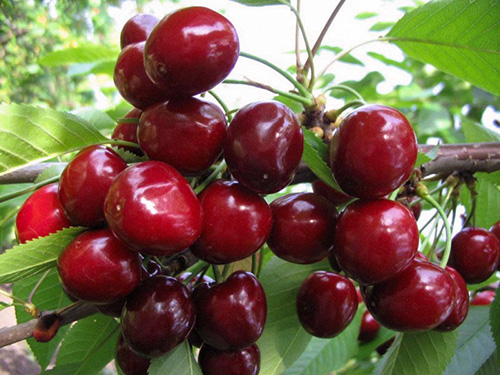
Large trees (up to 5 - 6 meters in height); the crown is broad-pyramidal, with good foliage, of medium density, with age it becomes more spreading and thickened. The stem is thick enough; the bark of the trunk is rough, gray-brown in color. Skeletal branches are covered with reddish-brown bark, the angle of departure from the trunk is 45-60 degrees. Shoots 5 mm thick, curved in shape, painted gray-brown. Lentils are rare. Vegetative buds 6.4 × 3.3 mm in size, cone-shaped, colored brown. The leaves are 19 × 10 cm in size, broadly oval or obovate in shape, with a sharp transition to the apex, the edge is framed by a double-serrate serration. The length of the petioles is 4.5 cm, at the base of each leaf blade there are 2 bean-shaped glands, painted in a greenish-brown color.
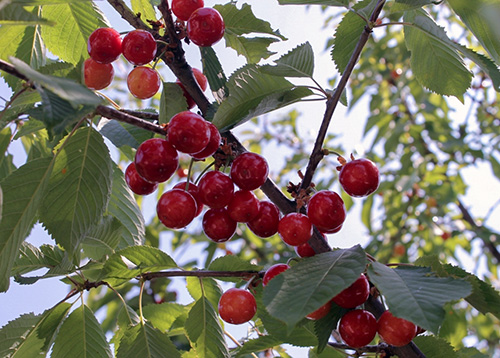
Cherry fruits Valery Chkalov are large (weighing up to 6 - 8 grams), rounded and wide-heart-shaped, blunt apex. The skin is thin, dark red (when fully ripe, it is almost black-red). The juice has an intense dark red color. The bones are large (weighing 0.37 grams), almost round, cream-colored, semi-detached from the pulp. The stalks are of medium length (4 - 4.5 cm), thick, firmly attached to the berries. The separation from the stalks is wet (with the release of juice).
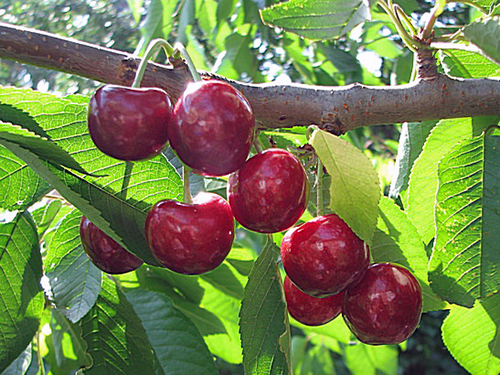
The pulp is dark red, with pink veins, semi-girly consistency, juicy, excellent taste, dessert type. In terms of chemical composition, the fruits contain: dry matter (13.5%), the amount of sugars (10.7%), free acids (0.6%), ascorbic acid (21.5 mg / 100 g fr wt). The purpose of the variety is universal. Most often it is used fresh and in cooking when making desserts; also berries are well suited for preservation.
The level of early maturity is average: fruiting begins in the 5th year from the moment the seedlings are planted.
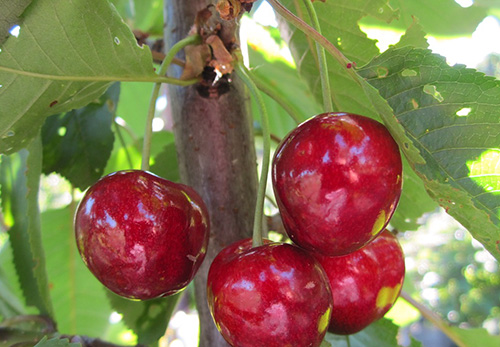
Trees bloom early (early May). Fruits ripen early (in early June). For example, in the Donetsk region of Ukraine, ripening occurs on June 8-10.
The variety is self-fertile. Among the best pollinators of cherries are Valery Chkalov varieties: Aprilka, Bigarro Burlat, Zhabule, Skorospelka, June early; from acceptable - Yaroslavna, Dniprovka, Early stamps.
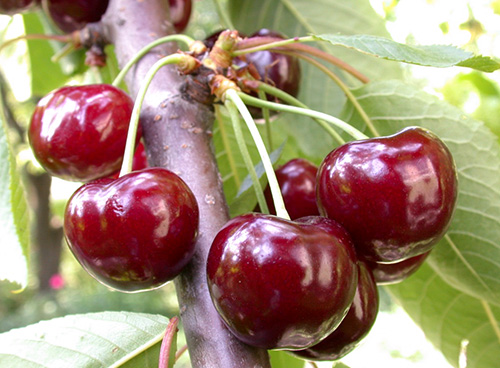
The potential productivity of the variety is assessed as high. Yields annually. Under the conditions of Crimea, over 10 years of fruiting, the average yield of 10 - 19-year-old trees was 62 kg of fruits / village, the maximum level was recorded in trees at the age of 12 years - 174 kg / village. Under the conditions of the Krasnodar Territory, the average productivity of 10-year-old trees is 24 - 32 kg / v.
The general level of winter hardiness and frost resistance is high: at a temperature of minus 23.5 ° C, flower buds freeze up to 70% as much as possible.
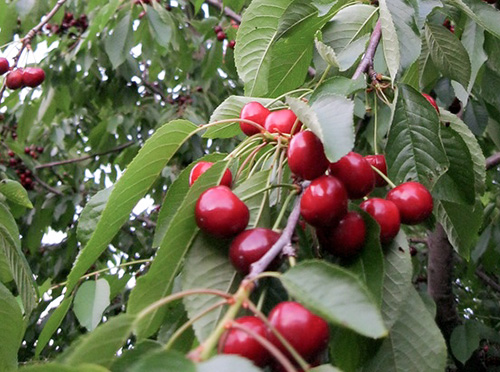
The overall level of disease resistance is medium. The defeat of coccomycosis can reach 4 points. The variety is not resistant to gray mold. It has relative field resistance to other fungal diseases.
The main advantage of cherries Valery Chkalov is recognized as large fruits of dessert taste and early ripening.
A significant disadvantage for the variety is its susceptibility to coccomycosis and gray rot.
On the basis of this cherry, varieties such as Donetsk beauty, Farewell, Annushka, Gift to the hero of the day, Valeria, Donetsk coal, etc. were bred.
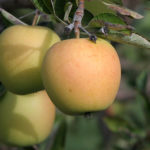
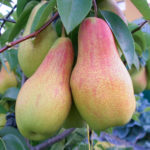
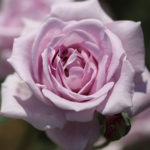
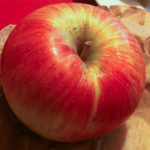

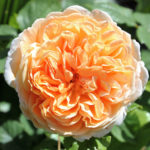



In our region, there are cold winters with frosts down to minus 25 degrees, therefore, when growing cherries (especially black-fruited ones), problems may arise.
Valery Chkalov is no exception, but I and my friends summer residents still plant this variety, because of the wonderful large berries with sweet, juicy dark pulp.
If during the ripening of the fruits (mid - end of June) there are frequent rains, then the fruits are sometimes affected by rot, but this happens every few years.
Of the varieties with dark fruits, I think this one is most suitable for our climate. But it is less hardy than varieties with yellow and pink fruits.
Pests (worms), unfortunately, also love these delicious berries much more than others. Therefore, cherries require mandatory processing from pests.
Valeriy Chkalov is the most widespread variety of sweet cherry in our Donbass. All my neighbors in the country must have it. I have a young tree (5 years old). What I want to note is that the tree grows very quickly. Necessarily requires annual pruning and shaping of the crown. I have not encountered diseases, pah-pah, (I always carry out preventive spraying throughout the garden). The harvest has not yet been large enough, but enough to "eat". I look forward to more, because I see mature trees near neighbors and I know how much can be harvested per season. The berry tastes fabulous, large, beautiful, ripens very early. The variety suits me absolutely, I don't even look towards others.
Tell me, do you grow this variety alone, or there are other varieties of pollinators. I just planted two trees: Chkalov and Iput. I am worried whether they will be pollinated. And then they write everywhere that they are self-infertile and that pollinators must also be planted, and there is no more space on the site.
Cherry Valery Chkalov got me from the previous owners of the summer cottage. The tree is over 25 years old. The yields are excellent every season. With good care, the tree can produce 10 buckets of sweet, fleshy berries. The crown is about 7 meters in diameter. This variety ripens in Ukraine on the 20th of May. The berries are very large, black-red, heart-shaped fruit with a blunt tip. The fruits are best picked as they ripen, as they ripen unevenly. In the rainy season, it is prone to decay, does not even have time to ripen. In favorable weather, the berries can delight any gourmet.
We also have Valery Chkalov - an old-timer. It has been growing in the summer cottage of my parents for thirty years, probably. They rejuvenated him more than once, but his life was running out and his parents decided to replace him with ... young Valery Chkalov. In the spring we do one treatment against pests and every year with a delicious berry. In the past, so much was imposed, but such a small one. But people in the market, if they tried, took 2 kg each, which caused bewilderment among the sellers of large berries in the neighborhood. We start harvesting when the cherry turns dark red and be sure to leave a twig for the kids so that the cherry is ripe almost to blackness. The only thing is that the birds bother you, protection from birds is needed, otherwise they will peck everything.